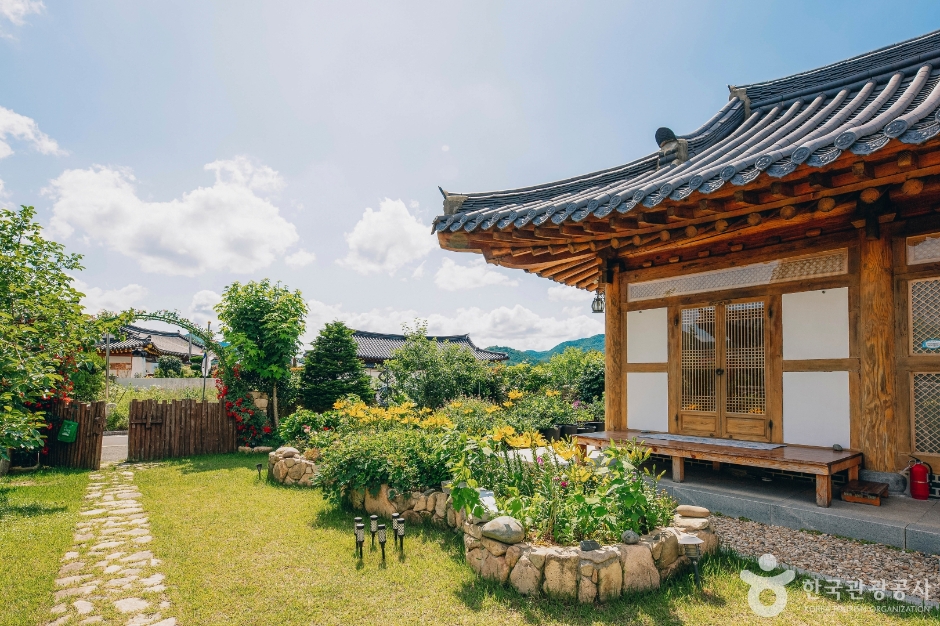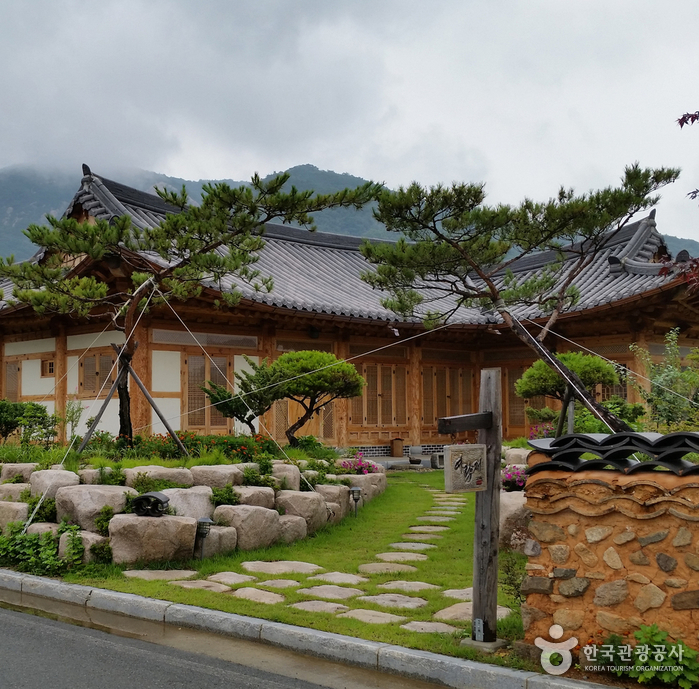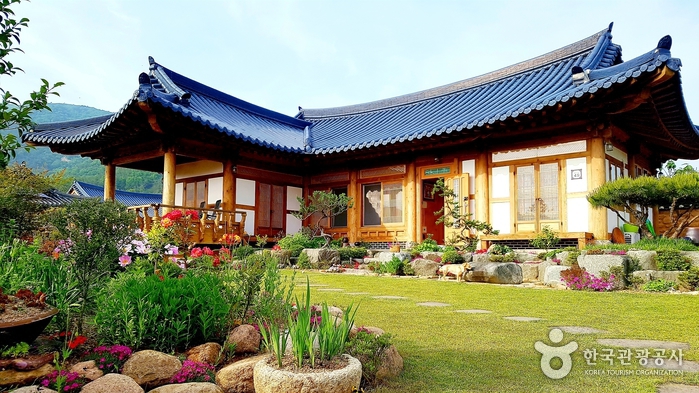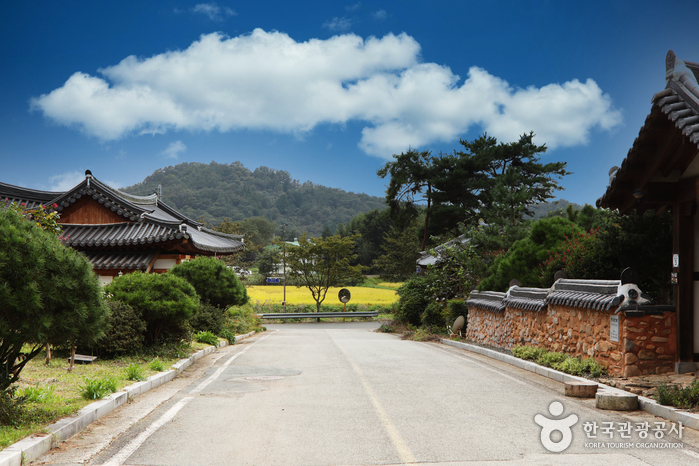Dalbit Hanok Experience Byeolyu Punggyeong (달빛한옥체험 별유풍경)
18.0Km 2024-10-30
32 , Dalbithanok-gil, Gangjin-gun, Jeonnam-do
+82-10-2038-7755
Dalbit Hanok Experience Byeolyu Punggyeong is a hanok accommodation built using natural materials, such as red clay, cypress, and soil. It is located in the inner alley of Dalbit Hanok Village in Gangjin, Jeonnam-do. There are two guest rooms, Pine Scent and Cypress Tree, where thick cypress logs are placed to softly exude the aroma of phytoncide, and the living room with hanging rafters has wooden furniture to provide a sense of comfort and coziness. The yard is adorned with colorful flowers. Breakfast is served with vegetables grown in the garden that are pollution-free.
Yeorakjae (여락재)
18.0Km 2024-10-30
38 , Dalbithanok-gil, Gangjin-gun, Jeollanam-do
+82-10-2633-7727
At Yeorakjae, located in Dalbit Hanok Village in Gangjin, Jeollanam-do, you can experience the simple joys of everyday life in a space called a hanok. The hanok was built with wood and soil in the old-fashioned manner, and its interior was furnished in a modern style to enhance comfort. There are two rooms, Full Moon and New Moon. Full Moon features a spacious living room and a numaru (balcony-like raised veranda) that may be used as a study or for tea ceremonies. In New Moon, there is a numaru with a large window and an attic. A beam projector and an AI speaker are installed in each room. Welcome tea and a hearty breakfast are provided.
Haerodang[Korea Quality] / 해로당[한국관광 품질인증]
18.0Km 2024-10-30
57 , Dalbithanok-gil, Gangjin-gun, Jeollanam-do
+82-10-9417-7517
Haerodang is a hanok accommodation located in Gangjin Dalbit Hanok Village in Boseong, Jeollanam-do. There are three rooms made of red clay scented with the aroma of cypress trees. The Sunset room is the largest room and has a toenmaru (narrow wooden porch) from which you can view the ridge of Wolchulsan Mountain. Sandeuljeong is the coolest during the summer, but it is extremely cold during the winter, therefore it is not operated during the winter months. There is a beautiful pavilion, an outdoor table, and a rocking swing in the yard. Breakfast is provided at no charge.
Bogeumjari[Korea Quality] / 보금자리[한국관광 품질인증]
18.0Km 2024-10-30
55 , Dalbithanok-gil, Gangjin-gun, Jeollanam-do
+82-10-4714-1951
Bogeumjari is a cozy accommodation located in Gangjin Dalbit Hanok Village, Boseong, Jeollanam-do. It has two rooms, one of which is a Gudeul room, an underfloor heated room heated by wood burning in the furnace and with walls made of cypress. The Numaru room has a separate door leading to the outer numaru and pavilion. Sitting on the pavilion in the middle of the yard, you can see the ridge of Wolchulsan Mountain and the green tea fields in the distance. Welcome tea, refreshments, and complimentary breakfast are provided.
Dalbit Smile (달빛미소)
18.1Km 2024-12-23
49 , Dalbithanok-gil, Gangjin-gun, Jeonnam-do
+82-10-7749-0887
Dalbit Miso (‘Moonlight Smile’) is a hanok guest house in Dalbit Hanok Village, Gangjin, Jeonnam-do. All three guestrooms are Korean-style with ondol underfloor heating, are decorated with folk paintings and old-time furniture, and exude coziness. The Dalbit Room has numaru(a raised floor), while the Miso Room has a jjongmaru(wooden veranda); from here guests will enjoy the beautiful scenery of Wolchulsan National Park and the scent rising from the green tea fields. The guest house offers a hearty breakfast. Baegundong Garden and Wolchulsan National Park are 5-10 minutes away by car.
Nestle for You and I[Korea Quality] / 너와 나의 둥지[한국관광 품질인증]
18.1Km 2024-10-30
42-1 , Dalbithanok-gil, Gangjin-gun, Jeollanam-do
+82-10-7608-2973
Nestle for You and I is a hanok accommodation located in Dalbit Hanok Village in Gangjin, Jeollanam-do. It has a spacious living room and yard with plenty of room for children to play, and the toenmaru (narrow wooden porch) under the eaves offers a great vantage point for viewing the hanok yard and the surrounding nature of Gangjin. There are three guest rooms: Haetnim and Dalnim come with a numaru (balcony-like raised veranda), and the detached building is equipped with a TV and refrigerator. There is a fireplace in the living room where you can enjoy a hearty, complimentary breakfast.
Dalbit Hanok Suryuhwagae [Korea Quality] / 달빛한옥 수류화개 [한국관광 품질인증]
18.1Km 2024-10-30
5, Dalbithanok-gil, Gangjin-gun, Jeollanam-do
+82-10-4140-4884
Located in Gangjin Dalbit Hanok Village, Suryuhwagae is an accommodation in a form of a traditional Korean housing that stands in front of magnificent Wolchulsan Mountain and filled with green tea aroma that lingers from the breeze coming from Wolchulsan Dawon (tea plantation). The warm ambiance makes guests feel as if visiting a relative’s house in the countryside. The picturesque scenery of the hanok with a yard filled with flowers is surely impressive. The owner serves welcome tea when guests arrive. There are only two guest rooms: Byeolbit Room and Dalbit Room. The two rooms are good for two and three guests, respectively, or can be booked together to enjoy the whole hanok without other guests. Both rooms each have a numaru (hanok balcony) and a private bathroom. Through the numaru window, guests can enjoy the view of the grass yard and the starry sky at night. Guests are served healthy Korean food as complimentary breakfast. The owner prepares a healthy meal with crops picked from the garden.
Gangjin Moonlight Hanok Village (강진달빛한옥마을)
18.1Km 2024-04-04
2 Dalbithanok-gil, Seongjeon-myeon, Gangjin-gun, Jeonnam-do
This village with 29 hanok (traditional Korean house) is surrounded by Wolchulsan Mountain like a folding screen. About 10 of those unique houses offer a friendly hanok lodging experience for tourists by renting out one or two guestrooms. It is fun to see the yards of each house decorated differently from its front yard. The observatory at the village offers a panoramic view of towering Wolchulsan Mountain, expansive tea fields, rice paddies, and the cozy Gangjin Moonlight Hanok Village at a glance.
Byeolbaragi House[Korea Quality] / 별바라기집[한국관광 품질인증]
18.1Km 2024-10-30
46 , Dalbithanok-gil, Gangjin-gun, Jeollanam-do
+82-10-4623-1375
Byeolbaragi House is a hanok guesthouse located in Dalbit Hanok Village in Gangjin, South Jeolla Province, south of the Wolchulsan National Park. Upon entering, you are greeted by the fragrant scent of green tea, the red mailbox at the entrance, and the lush green lawn. There are two guest rooms, Saetbyeolbang and Eunhasu, both traditional Korean rooms with separate bathrooms. A long table with a fireplace on one side of the living room is the centerpiece of this property, and it is the perfect setting for a party with friends. Breakfast is provided free of charge.
Hyuhyudang[Korea Quality] / 휴휴당[한국관광 품질인증]
18.1Km 2024-10-30
42-3 , Dalbithanok-gil, Gangjin-gun, Jeollanam-do
+82-10-6630-1507
Located in Dalbit Hanok Village in Gangjin, Jeollanam-do, Hyuhyudang is a traditional hanok guesthouse with a stunning view of Wolchulsan Mountain. There are two guest rooms in the guesthouse. Daerae is a gudeul room heated by wood burning in the furnace, and Meoru is a bedroom with a wooden bed. In the Jukrojisil, a tea room, guests can enjoy a tea ceremony while overlooking the scenic landscape of Gangjin. Guests are provided with free breakfast and bedding that has been carefully hand-sewn by the owner.


![Haerodang[Korea Quality] / 해로당[한국관광 품질인증]](http://tong.visitkorea.or.kr/cms/resource/84/2991384_image2_1.jpg)
![Bogeumjari[Korea Quality] / 보금자리[한국관광 품질인증]](http://tong.visitkorea.or.kr/cms/resource/70/2991370_image2_1.jpg)

![Nestle for You and I[Korea Quality] / 너와 나의 둥지[한국관광 품질인증]](http://tong.visitkorea.or.kr/cms/resource/23/2991323_image2_1.jpg)
![Dalbit Hanok Suryuhwagae [Korea Quality] / 달빛한옥 수류화개 [한국관광 품질인증]](http://tong.visitkorea.or.kr/cms/resource/65/2808465_image2_1.png)

![Byeolbaragi House[Korea Quality] / 별바라기집[한국관광 품질인증]](http://tong.visitkorea.or.kr/cms/resource/63/2991363_image2_1.jpg)
![Hyuhyudang[Korea Quality] / 휴휴당[한국관광 품질인증]](http://tong.visitkorea.or.kr/cms/resource/58/2803458_image2_1.jpeg)
 English
English
 한국어
한국어 日本語
日本語 中文(简体)
中文(简体) Deutsch
Deutsch Français
Français Español
Español Русский
Русский